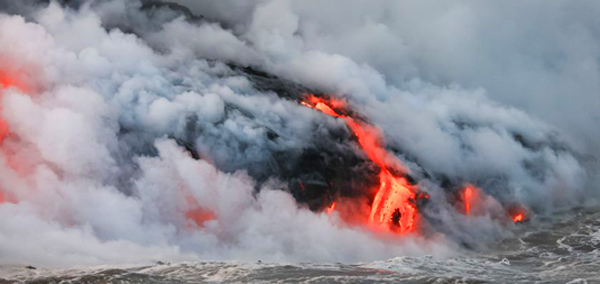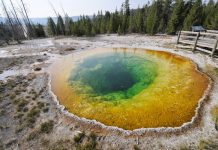
Water-filled micropores in hot rock may have acted as the nurseries in which life on Earth began. A team at Ludwig-Maximilians-Universitaet (LMU) in Munich has now shown that temperature gradients in pore systems promote the cyclical replication and emergence of nucleic acids.
How and in what habitats did the first life-forms arise on the young Earth? One crucial precondition for the origin of life is that comparatively simple biomolecules must have had opportunities to form more complex structures, which were capable of reproducing themselves and could store genetic information in a chemically stable form. But this scenario requires some means of accumulating the precursor molecules in highly concentrated form in solution.
In the early oceans, such compounds would have been present in vanishingly low concentrations. But LMU physicists led by Professor Dieter Braun now describe a setting which provides the necessary conditions. They show experimentally that pore systems on the seafloor that were heated by volcanic activity could have served as reaction chambers for the synthesis of RNA molecules, which serve as carriers of hereditary information in the biosphere today.
“The key requirement is that the heat source be localized on one side of the elongated pore, so that the water on that side is significantly warmer than that on the other,” says Braun. Preformed biomolecules that are washed into the pore can then be trapped, and concentrated, by the action of the temperature gradient — thus fulfilling a major prerequisite for the formation and replication of more complex molecular structures. The molecular trapping effect is a consequence of thermophoresis: Charged molecules in a temperature gradient preferentially move from the warmer to the cooler region, allowing longer polymers in particular to be securely trapped. This is an important factor in the evolution of nucleic acids such as RNA and DNA, simply because longer molecules can store more genetic information.
Recreating rock pores in the laboratory
Braun and his colleagues have shown that this mechanism works in the laboratory: “We used tiny glass capillary tubes to construct an analog of the natural pores found in rock, heated the pore from one side and allowed water containing dissolved fragments of linear DNA of varying lengths to percolate through it. Under such conditions, the long strands are indeed trapped within the pore,” Braun explains. “Pores that were exposed to heat are frequently found in igneous rock formations, and they were certainly common in rocks of volcanic origin on the early Earth. So this scenario is quite realistic. And the temperature effect is enhanced by the presence of metal inclusions within the rock, which conduct heat at rates 100 times higher than water.”
Temperature gradients and replication
Not only are nucleic acids retained in the pore, they are also capable of replication under these conditions. In the hotter zone, double-stranded strands are separated into its component strands within minutes. The single strands can then be transported by convection — cyclical flow along the pore perpendicular to the orientation of temperature gradient — back to the colder region of the pore. Here they encounter the chemical precursors from which each DNA strand is built, which are fed into the pore by a continuous inflow. The preformed strands then act as templates for the polymerization of complementary strands. This cycle makes it possible not only to replicate the strands but also to elongate them by stitching fragments together. When the nucleic acids accumulate to levels beyond the storage capacity of the pore, newly replicated molecules can escape and colonize neighboring pore systems.
Thus, the LMU group has succeeded in constructing a system which permits autonomous and continuous Darwinian evolution of ever more complex biomolecules — thus defining realistic conditions under which life could in principle have evolved. “Life is fundamentally a thermodynamic non-equilibrium phenomenon. That is why the emergence of the first life-forms requires a local imbalance driven by an external energy source — for example, by a temperature difference imposed from outside the system,” Dieter Braun explains. “That this can be achieved in such a simple and elegant way was surprising even to us. The success of the project is a tribute to the close cooperation between all members of the team.”
Reference:
Moritz Kreysing, Lorenz Keil, Simon Lanzmich, Dieter Braun. Heat flux across an open pore enables the continuous replication and selection of oligonucleotides towards increasing length. Nature Chemistry, 2015; DOI: 10.1038/nchem.2155
Note : The above story is based on materials provided by Ludwig-Maximilians-Universität München.










